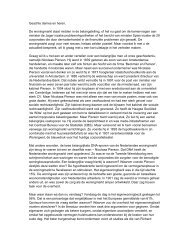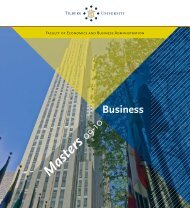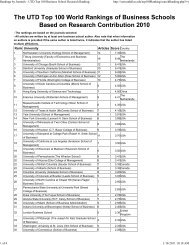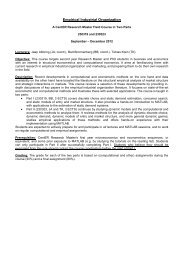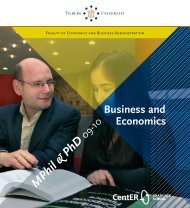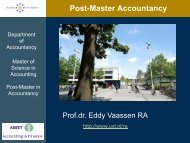Predicting the past - Tilburg University, The Netherlands
Predicting the past - Tilburg University, The Netherlands
Predicting the past - Tilburg University, The Netherlands
Create successful ePaper yourself
Turn your PDF publications into a flip-book with our unique Google optimized e-Paper software.
So far <strong>the</strong>re are no new problems. Vector calculus is well established and well understood.<br />
But suppose next we want to know <strong>the</strong> second derivative, that is <strong>the</strong> derivative of <strong>the</strong><br />
derivative, <strong>the</strong> so-called Hessian. <strong>The</strong>n we need to differentiate <strong>the</strong> first derivative, which<br />
is a matrix. How do we do that? Or suppose <strong>the</strong> functions that we start off with are<br />
arranged in a matrix, not in a vector, for example <strong>the</strong> inverse function F(X)=X -1 .<strong>The</strong>n we<br />
require a <strong>the</strong>ory of matrix calculus.<br />
<strong>The</strong> <strong>the</strong>ory that Heinz and I developed is based on two pillars. First, we employ<br />
differentials, not derivatives, and this has <strong>the</strong> advantage that <strong>the</strong> dimensions do not grow<br />
as we differentiate. <strong>The</strong>y always stay <strong>the</strong> same: <strong>the</strong> differential of a matrix is a matrix of<br />
<strong>the</strong> same dimension. Second, we transform matrix functions to vector functions (and in<br />
<strong>the</strong> end we transform <strong>the</strong>m back), so that we can employ <strong>the</strong> existing <strong>the</strong>ory of vector<br />
calculus.<br />
This may sound easy (at least to <strong>the</strong> ma<strong>the</strong>matically inclined amongst you), and in <strong>the</strong> end<br />
it is quite easy, but it took us fifteen years to put it all toge<strong>the</strong>r in a satisfactory framework.<br />
Not only did we have to understand and develop calculus in <strong>the</strong> context of differentials,<br />
but we also had to fight with colleagues who had invented <strong>the</strong>ir own ad-hoc methods,<br />
not ma<strong>the</strong>matically correct because not based on <strong>the</strong> underlying concept of derivative.<br />
Even today this battle is not completely won, and I recently called <strong>the</strong>se o<strong>the</strong>r definitions<br />
and methods ‘derisatives’ (instead of derivatives), not causing much amusement in <strong>the</strong>se<br />
circles.<br />
At <strong>the</strong> end of this long period I had become an expert in matrices and matrix calculus,<br />
and I could have stayed with this subject for <strong>the</strong> rest of my career. Maybe I should have<br />
done that. But I did not see any major new challenges in this field. It was time to change<br />
subject.<br />
Maximum likelihood and asymptotic <strong>the</strong>ory<br />
Maximum likelihood is a <strong>the</strong>ory of estimation, probably <strong>the</strong> best-known <strong>the</strong>ory of<br />
estimation. Estimation is at <strong>the</strong> heart of econometrics. Consider <strong>the</strong> following problem.<br />
<strong>Predicting</strong> <strong>the</strong> <strong>past</strong> 7




